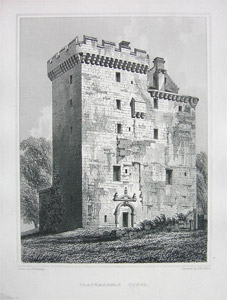WordPress database error: [Got error 28 from storage engine]
SELECT t.*, tt.*, tr.object_id FROM wp_terms AS t INNER JOIN wp_term_taxonomy AS tt ON tt.term_id = t.term_id INNER JOIN wp_term_relationships AS tr ON tr.term_taxonomy_id = tt.term_taxonomy_id WHERE tt.taxonomy IN ('category', 'post_tag', 'post_format') AND tr.object_id IN (3804, 3825, 4055, 5307, 5643, 38763, 38770, 53779) ORDER BY t.name ASC
Family of Bruce History

Clackmannan Tower was built by David II sometime in the 1300s and then he sold it to his cousin Robert Bruce in 1359.
It is possible to trace the descendancy of this famous clan to Normandy, France in the 11th century. Robert de Brus followed William the Conqueror, Duke of Normandy to England in 1066.. One of his relatives, Robert de Brus, became a companion-in-arms to Prince David in his visit to the court of Henry I of England, afterwards David I of Scotland, following him north as he went to reclaim his kingdom in 1124.
At an important battle in the English Civil War, the Battle of the Standards in 1138, Scottish forces were defeated. de Brus captured his own second son, Robert, who did not share his father’s allegiance to the English forces resisting the invading Scottish forces led by David. Robert ultimately returned to the lands of Annandale, and as a symbol of his defiance, abandoned his father’s arms of a red lion on a silver field, to adopt the famous red saltire.
The foundation of the royal house of Bruce was laid when Robert, 4th Lord of Annandale, married Isobel, niece of William of Lion. Not only did this confirm the regal gesture of the grant of the lands of Annandale, but it was the foundation upon which all future Bruce claims to the crown would be made. Furthermore, Robert de Bruce was in 1255 nominated one of the Regents of the Kingdom of Scotland, and the guardian of Alexander III.
The race for the succession to the Scottish crown was opened up by the death of Alexander III in 1286. The main competitor to the Bruce was the Balliol family. The death of the child heir to the throne, Margaret, the Maid of Norway, in 1290 intensified the competition. In 1290 he claimed the Crown as the nearest heir to Alexander III.
It could be argued the actions of Edward were duplicitous:
On the one hand, to avoid a potential civil war, it is said the rival families asked Edward I to act as arbiter. On the other, he ignored the claims made by the Bruce in 1290, in preference to the Balliols, through a strict interpretation of the laws of succession attributed to King Malcolm MacKenneth.
Not content with his judgement of 1292 that favoured John Balliol, Edward I took the opportunity to assert a right of overlordship over Scottish affairs. The response by Balliol was armed resistance though this met with failure at the Battle of Dunbar in 1296. As a consequence of Dunbar, the struggle for succession to the Scottish throne intensified, though taking a new form as a contest between the Comyns and Bruces.
The 8th Robert the Bruce (1274 – 1329), of historical repute, showed Machiavellian qualities in winning this contest. On his invitation John Comyn met with him on February 1306 in the church of Minorite Friars at Dumfries. The incident that followed has acquired notoriety: Robert stabbed his rival in the heart, thus emphatically staking his claim to the Crown.
Robert was crowned King at Scone palace on 27th March 1306. Though he was excommunicated for this act of sacrilege, he continued to show the resolve that had won him the crown in dissuading the sceptics who doubted the validity of his claim and the substance of his leadership. This struggle for Scottish independence culminated in the Battle of Bannockburn in 1314 which heralded a period of reconstruction and the successful process of unifying a war-torn nation.
The treaty of Northampton in 1328 ratified the Scottish independence for which Robert the Bruce, 7th Lord of Annandale, 2nd Earl of Carrick, and Scottish regent had fought so hard. The extent to which he was revered can be seen in the actions of Sir James Douglas who, on Robert the Bruce’s death in 1329, sought to preserve the sanctity of the dead King’s soul by transporting his heart to the Holy Land. It found its way to Spain, but no further as Douglas died, though it found eventual rest in Scotland in Melrose.
One of the less famous Bruce descendants was the seventh Earl of Elgin, the famous diplomat who devoted his own private fortune to reclaiming the ‘Elgin Marbles’, or the marbles of the Pantheon, that were rapidly decaying beyond repair.
Clan Bruce Posts
Quick Links to Clan Bruce Products from The Clan Shop
- Bruce Tartan Tie
- Bruce Tartan Pocket Square Handkerchief
- Bruce Tartan Scarves
- Bruce Tartan Kilts
- Bruce Clan Crest Badge
- Bruce Clan Crest Mug
- Bruce Clan Crest T-Shirts
- Bruce Clan Crest Belt Buckle
- Bruce Phone Covers
- Bruce Tartan
- Bruce Clan Crest Crystal Glasses
- Bruce Clan Crest Cufflinks
- Bruce Clan Crest Sgain Dubh
- Bruce Clan Crest Kilt Pin
- Bruce Clan Crest Plaques













